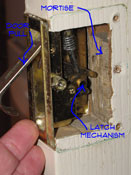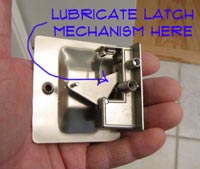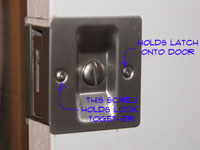 Fixing a pocket door latch will often involve some adjustments to the pocket door. When the door and the strike plate are not aligned correctly, the door will not latch. Sticking or stiff pocket door latches can be lubricated to get working freely.
Fixing a pocket door latch will often involve some adjustments to the pocket door. When the door and the strike plate are not aligned correctly, the door will not latch. Sticking or stiff pocket door latches can be lubricated to get working freely.
For related information, see the articles 'Troubleshooting Pocket Doors', 'Adjusting Pocket Doors' and 'Fixing a Pocket Door Off the Track'.
Pocket Door Latches and Locksets - General Information
Most pocket door locks are not locks at all. They are more like latches. They offer a level of privacy when the door is closed. But it is not that hard to open them from the other side.
A pocket door latch or lockset differs from a normal door lock. A standard door lock has handles or knobs that protrude out of the door. A pocket door has to slide into a narrow pocket that is built into the wall. There is no room for knobs. What do you do?
For this reason a special type of latch or lock was designed for this type of door. The lock is flush with the door panel. It has insets in it for a thumb turn or sometimes a sliding mechanism. The thumb turn or slide operates the latch. When the door is closed there is a flip handle that acts as a pull. Otherwise you would not be able to get the door open.
 Pocket door locks have similar problems to regular locks. They can become misaligned and the mechanism inside can get stiff. Another thing to note is that a pocket door lock is mortised differently than a standard door. When purchasing a new door slab, you don't want to get one that is bored for a standard door. Simple lubrication and adjustment will solve most problems with this type of lock.
Pocket door locks have similar problems to regular locks. They can become misaligned and the mechanism inside can get stiff. Another thing to note is that a pocket door lock is mortised differently than a standard door. When purchasing a new door slab, you don't want to get one that is bored for a standard door. Simple lubrication and adjustment will solve most problems with this type of lock.
Fixing a Pocket Door Latch - The Issues Involved
What Can You Save? - Lubricating a lock and adjusting a door will take only a few minutes for a carpenter. He will charge you for coming out and this could run $50 to $75. Replacing a lock will run $75 to $100.
How Hard Could It Be? - A pocket door lock is a fairly simple device, most repairs are not hard. These repairs will have a Difficulty Level of: Simple. These repairs require a Skill Level of: Handyman. For and explanation of the terms in this section, see 'How to Use This Site'.
Check the Simple Things! - Lubricating the lock is the simplest thing you can do. A stiff or frozen lock will likely respond to some silicone lubricant.
What Can Go Wrong? - Be careful when you take a lock apart. Losing a part could cause the lock to quit working. Adjusting the door the wrong way can cause the lock to quit working altogether.
Lubricating a Pocket Door Lock

Lubricating a pocket door lockset is not too hard. However, you do have to take the latch apart to get to most of the parts that need attention. Latches and locksets that are sticking or making noise need lubrication.
Before you begin lubricating your pocket door latch you want to have a can of lubricant that is suitable for door locks. A silicone based lubricant is best. You also want to have a rag on hand to wipe up any excess oil.The lock assembly probably consists of three parts. The center latch mechanism.
This mechanism also has the flip out handle that acts as a door pull. The other two parts are the cover plates. Each plate has a thumb screw or slide that operates the latch.
 You want to use a good quality silicone spray to lubricate locks. Use the long slender tube that comes with most spray lubricants. Keep a rag handy to wipe up any excess oil.
You want to use a good quality silicone spray to lubricate locks. Use the long slender tube that comes with most spray lubricants. Keep a rag handy to wipe up any excess oil.
Gingerly spray the oil into the moving parts. Work the latch back and forth until it moves freely. Make sure you oil all the parts including the slides or thumb screws. Use the rag to wipe up any excess oil. When you are sure the lock is working properly, you can put it back in.
Removing the Pocket Door Latch
 A Pocket door lock is held together with screws. There are probably four screws that are toward the center of the door that hold the lock assembly to the door. Use a screwdriver to take these screws out. The entire assembly should slide out, once the screws are removed.
A Pocket door lock is held together with screws. There are probably four screws that are toward the center of the door that hold the lock assembly to the door. Use a screwdriver to take these screws out. The entire assembly should slide out, once the screws are removed.
The three pieces are also held together with screws. It will be one or two on each side. You probably do not need to take these screws out. With the lock out of the door, you can inspect it to see what your problem might be. If nothing is broken and the lock is just difficult to operate, lubrication is the likely answer. See the next step.
Lubricating the door lock should have taken care of any noise or sticking problems with your latch. We hope this article helped to get your pocket door working properly.
Troubleshooting Pocket Door Latch Problems
Trouble with the latch closing is usually tied to the alignment with the strike plate. Pocket doors can be adjusted, unlike conventional swinging doors. The article 'Adjusting a Pocket Door' gave you instructions on how to get the door aligned properly.
When all else fails, you can replace your latch. There are not a lot of choices with this type of hardware. In the article on 'Replacing a Pocket Door Latch' we covered purchasing and installing a new lockset.
Summary
We hope that this article helped with your pocket door lock. You should have been able to take care of your problem without too much trouble.
So what did you find out about your pocket door lock? Did it just need to be oiled. Many times a little lubrication is all that is needed. Was the strike plate not lining up with the latch? Again a simple adjustment should have taken care of this problem.
Replacing the lock is often done when the old one gets tired looking. This is not a big job either, as long as you get a lock that is the same size. Now that you have completed this task you can look for other home repair projects.
Hopefully you have been able to take care of the issues with your pocket door latch.

